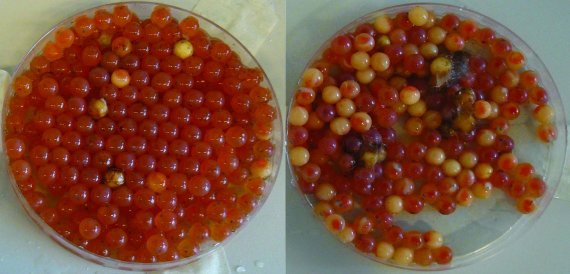Healthy eggs (left) and infected eggs. (photo: Inge de Bruijn)
The target of the study was Saprolegnia, an ‘oomecyte’ which looks like a mould but is actually more closely related to brown algae. It afflicts about 10 percent of salmon eggs, on average, which then have to be removed from the brood by hand. In the fast-growing aquaculture sector, there is a need for a good, sustainable treatment, especially since the compound malachite green was banned in the European Union in the nineteen nineties.
Protection
In their search, the Wageningen researchers obtained twelve cargoes of salmon eggs from a Scottish fish farm, some of them healthy, some of them infested. In the lab, however, it made no difference where the ecologists looked. They found pathogens everywhere. So something was protecting the ‘healthy’ eggs. The difference turned out to be the bacterial communities living on the eggs. The bacterium Frondihabitans, which was over-represented on healthy eggs, proved in laboratory tests to be responsible for the difference.
We are busy trying to figure out the interaction between the micro-organisms and the fish eggs
Yiying Liu
It might seem strange that a bacterium, of all things, should protect its host. Yet such ‘good’ bacteria that provide protection against disease are found in many places, says Irene de Bruijn, a postdoc at Phytopathology during the study: ‘In soils too, there are sometimes bacteria which produced fungus-resistant substances with which they protect plants.’
Antibiotics
The salmon research is far from complete. Although one good bacterium has now been identified, PhD student Yiying Liu suspects that the true situation is more complicated: ‘Maybe there are more protective bacteria or they work together.’ But the crucial open question is how exactly the bacterium does its protective work. Tests indicate that it does not produce antibiotics and possibly does no more than occupy the spots where the moulds want to settle. Liu: ‘We really have no idea yet and we are busy trying to figure out the interaction between the micro-organisms and the fish eggs.’

